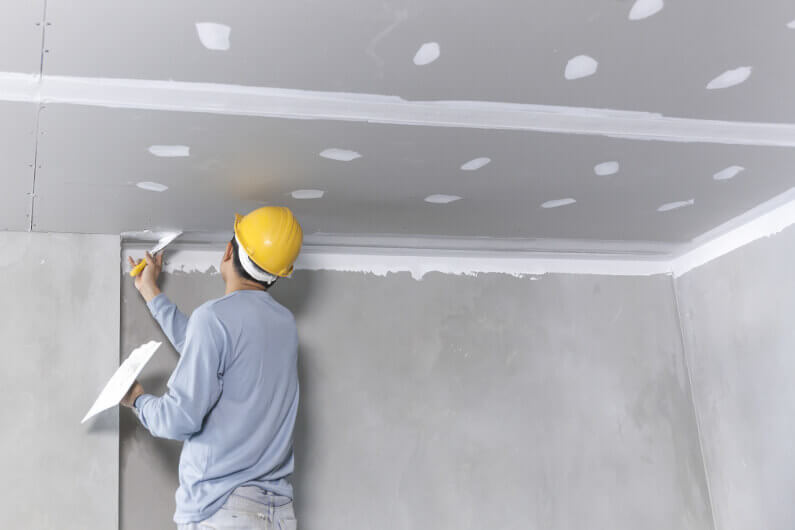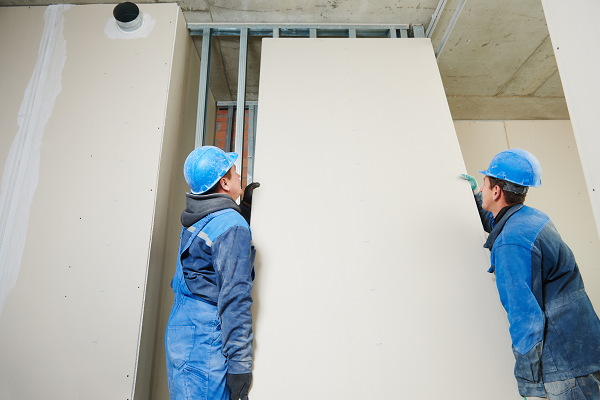Drywall Installation Facilitated: Tips for Perfect Results
Drywall setup is commonly regarded as a challenging task, yet with the ideal approach and knowledge, it can end up being a manageable undertaking. Understanding strategies for cutting, hanging, and ending up drywall can considerably influence the result.
Picking the Right Products
Picking the appropriate materials for drywall setup is crucial to attaining a long lasting and aesthetically pleasing finish. drywall contractor. The main component, drywall sheets, generally been available in various densities, with 1/2-inch sheets being common for interior walls. For areas requiring extra wetness resistance, such as bathrooms or kitchens, think about using green board or concrete board, which are particularly designed to stand up to moisture

Furthermore, selecting the appropriate bolts-- either nails or screws-- is necessary for safeguarding the drywall to the framework. Drywall screws are normally favored for their holding power and lowered risk of popping. Take into consideration the finishing touches such as guide and paint, which not only improve the look but additionally shield the drywall from dampness and wear.
Preparing the Installment Area
Before beginning the drywall installation process, it is important to prepare the setup area completely. This preparation entails several essential steps to guarantee a smooth and successful job. Clear the location of any kind of furniture, appliances, or obstructions that might prevent access. A tidy office reduces the threat of damage to existing things and allows for efficient motion during installation.
Following, inspect the wall surfaces and ceiling for any kind of flaws, such as splits, holes, or mold and mildew. Address these problems in advance; patch any problems and allow enough time for repair services to dry. Additionally, make sure that electrical outlets, switches, and pipes are appropriately positioned and made up, as this will certainly affect drywall positioning.
Take into consideration the ecological conditions also. A secure temperature level and humidity degree are essential for ideal attachment and efficiency of the drywall products. If necessary, utilize a dehumidifier or heating system to produce ideal problems.
Trimming and Hanging Drywall
The trick to efficient drywall installment lies in the accurate cutting and dangling of the panels. Begin by determining the area properly, taking into consideration any blockages such as electric outlets or windows. Make use of a straight edge and an utility blade to rack up the drywall along your measurements, after that snap it along the racked up line for a clean break. For more complex cuts, such as around electrical outlets, a drywall saw can be utilized for precision.

Constantly function from the top down and delegated right, ensuring that you preserve a staggered pattern to improve stability. Properly hanging the drywall sets the foundation for a smooth surface, inevitably causing premium outcomes in your drywall task.
Taping and Mudding Methods
While proper cutting and dangling of drywall establishes the stage, the following important step involves mastering taping and mudding methods to guarantee a seamless coating. Taping is necessary for strengthening joints and stopping fractures; it entails embedding tape into the applied joint substance (mud) Begin with a quality fiberglass or paper tape, using the tape over the joint and pushing it right into the wet mud using a taping blade, ensuring no air bubbles remain.
As soon as the tape remains in place, apply a slim layer of joint compound over the tape, feathering the edges to create a smooth transition to the drywall surface area. Enable this layer to dry entirely before sanding it gently to remove imperfections. Repeat this procedure, using additional layers of mud as required-- generally 2 to 3 layers-- while progressively widening the application area with each layer to achieve a seamless look.
After the final layer dries out, sand the surface with a fine-grit sandpaper up until smooth. drywall fort worth. Remember to wear a mask throughout fining sand to prevent inhaling dirt fragments. Understanding these taping and mudding find more information techniques is essential investigate this site for achieving a professional-quality finish in your drywall installment
Finishing Touches for Excellence
Attaining a remarkable drywall installment goes past mudding and taping; it culminates in the ending up touches that raise the total appearance. These last actions are essential in making sure a professional-grade surface that enhances the aesthetic appeals of your area.
Begin by fining sand the dried joint compound to produce a smooth surface. Use a fine-grit sandpaper and a fining sand block or pole sander for ideal control. Pay specific focus to corners and edges, as these locations often tend to require more meticulous work. After fining sand, wipe down the walls with a wet fabric to get rid of any type of dirt fragments, making certain a clean surface for painting.
Following, use a guide particularly created for drywall. This action is necessary, as it aids seal the joint compound and gives a consistent base for the topcoat. Once the guide dries out, inspect for any blemishes, and repair as required.
Conclusion
To conclude, successful drywall installment depends upon the mindful selection of products, thorough prep work of the setup location, and specific implementation of reducing and hanging methods. Proficiency of taping and mudding procedures is crucial for achieving a smooth coating. Furthermore, attention to ending up touches, consisting of priming and touch-ups, makes certain a professional-grade result. By sticking to these standards, the quality of handiwork can be dramatically improved, contributing to the overall aesthetic and performance of the area.
Drywall setup is commonly regarded as a complicated task, yet with the ideal method and understanding, it can become a workable venture.Selecting the proper products for drywall installment is crucial to accomplishing a sturdy and aesthetically pleasing surface.Prior to starting the drywall setup process, it is vital to prepare the installment location completely. Mastering these taping and mudding strategies is important for attaining a professional-quality surface in your drywall installment.
In conclusion, successful drywall installment hinges on the careful selection of materials, complete prep work of the installment location, and precise implementation of cutting and hanging strategies.